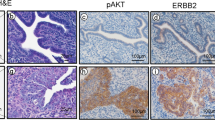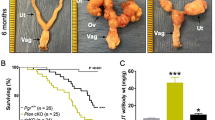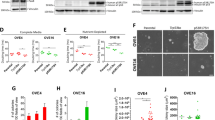Abstract
The etiology of carcinoma of the uterine endometrium (ECa) is poorly understood. However, loss of apoptosis is one of the major factors that allow cancer cells to survive and progress. Hec50co, a poorly differentiated human ECa cell line, is widely used in the investigation of ECa. Previously, Hec50co xenograft tumor model in nude mice developed an advanced phenotype, similar to that of uterine papillary serous carcinoma (UPSC). Importantly, loss-of-function mutation in tumor suppressor TP53 was found in 20–30% of all ECa and >90% of UPSC. Thus, understanding the status of TP53 in Hec50co is essential for using Heco50co as a model for UPSC. To obtain an accurate genotype–phenotype status of TP53 in Hec50co, we performed mutation and functional analysis of TP53 gene of Hec50co by RT-PCR, genomic-PCR, and cloning and expression of mutant and wildtype TP53 alleles. We found a novel 42-bp deletion mutation in the exon6–intron6 splice junction of TP53 (TP53.del42bp) leading to a 113-bp exon6-deleted/skipped transcript was identified in Hec50co. In addition, the other TP53 allele in Hec50co is inactivated through a large deletion. Adenovirus (AD) harboring wildtype full-length TP53 cDNA induces caspase-dependent apoptosis; while the AD-TP53.del42bp allele does not. In addition, messenger RNA of TP53.del42bp allele is stable whereas the protein product of TP53.del42bp allele is made but not stable. Taken together, we demonstrate that Hec50co is a TP53-null cell line possessing one TP53.del42bp allele and the other lost allele and therefore provides an excellent model to dissect the molecular and cellular bases of UPSC and other p53-null cancers.
Similar content being viewed by others
References
American Cancer Society. Cancer facts, figures. Atlanta [GA]: American Cancer Society (2005)
Jemal A, Siegel R, Ward E, Murray T, Xu J, Smigal C, Thun MJ Cancer statistics, 2006. CA Cancer J Clin 56: 106–130 (2006)
Rose PG. Endometrial carcinoma. N Engl J Med 335: 640–649 (1996)
Ellenson LH (2001) Endometrial cancer. In: Scriver C, Beaudet A, Valle D, Sly W, Childs B, Kinzler K, Vogelstein B, (eds). The metabolic & molecular bases of inherited disease 8. New York: McGraw Hill Publisher pp 1097–1104
Honda T, Kato H, Imamura T, Gima T, Nishida J, Sasaki M, Hoshi K, Sato A, Wake N Involvement of p53 gene mutations in human endometrial carcinomas. Int J Cancer 53: 963–967, (1993)
Berchuck A, Boyd J (1995) Molecular basis of endometrial cancer. Cancer 76: 2034–2040
Kihana T, Hamada K, Inoue Y (1995) Mutation and allelic loss of the p53 gene in endometrial carcinoma. Incidence and outcome in 92 surgical patients. Cancer 76: 72–78
Kong D, Suzuki A, Zou TT (1997) PTEN1 is frequently mutated in primary endometrial carcinomas. Nat Genet 17: 143–154
Graham JD, Clarke CL: Physiological action of progesterone in target tissues. Endocr Rev 18: 502–519, (1997)
Kumar NS, Richer J, Owen G, Litman E, Horwitz KB, Leslie KK: Selective down-regulation of progesterone receptor isoform B in poorly differentiated human endometrial cancer cells: implications for unopposed estrogen action. Cancer Res 58: 1860–1865, (1998)
Conneely OM, Mulac-Jericevic B, Lydon JP: Progesterone-dependent regulation of female reproductive activity by two distinct progesterone receptor isoforms. Steroids 68: 771–778, (2003)
Leslie KK, Kumar NS, Richer J: Differential expression of the A and B isoforms of progesterone receptor in human endometrial cancer cells. Only progesterone receptor B is induced by estrogen and associated with strong transcriptional activation. Ann N Y Acad Sci 828: 17–26, (1997)
Dai D, Wolf DM, Litman ES, White MJ, Leslie KK Progesterone inhibits human endometrial cancer cell growth and invasiveness: down-regulation of cellular adhesion molecules through progesterone B receptors. Cancer Res 62: 881–886 (2002)
Smid-Koopman E, Blok LJ, Kuhne LC: Distinct functional differences of human progesterone receptors A and B on gene expression and growth regulation in two endometrial carcinoma cell lines. J Soc Gynecol Invest 10: 49–57, (2003)
Hanekamp EE, Gielen SC, Smid-Koopman E: Consequences of loss of progesterone receptor expression in development of invasive endometrial cancer. Clin Cancer Res 9: 4190–4199, (2003)
Satyaswaroop PG, Clarke CL, Zaino RJ, Mortel R: Apparent resistance in human endometrial carcinoma during combination treatment with tamoxifen and progestin may result from desensitization following downregulation of tumor progesterone receptor. Cancer Lett 62: 107–114, (1992)
Arnett-Mansfield RL, deFazio A, Wain GV: Relative expression of progesterone receptors A and B in endometrioid cancers of the endometrium. Cancer Res 61: 4576–4582, 2001
Vogelstein B, Lane D, Levine AJ: Surfing the p53 network. Nature 408: 307–310, (2000)
Johnstone RW, Ruefli AA, Lowe SW: Apoptosis: a link between cancer genetics and chemotherapy. Cell 108: 153–164, (2002)
Vousden KH, Prives C P53 and prognosis: new insights and further complexity. Cell 120: 7–10, (2005)
Hengartner MO The biochemistry of apoptosis. Nature. 407: 770–776, (2000)
Soussi T, Beroud C: TP53 status in human tumors to evaluate clinical outcome. Nat Rev Cancer 1: 233–240, (2001)
Soussi T, Kato S, Levy PP, Ishioka C: Reassessment of the TP53 mutation database in human disease by data mining with a library of TP53 missense mutations. Hum Mutat 25: 6–17, (2005)
Polyak K, Xia Y, Zweier JL, Kinzler KW, Vogelstein B: A model for p53-induced apoptosis. Nature 389: 300–305, (1997)
Mihara M, Erster S, Zaika A: p53 has a direct apoptogenic role at the mitochondria. Mol Cell 11: 577–590, (2003)
Soussi T Focus on the p53 gene and cancer: advances in TP53 mutation research. Hum Mutat 21: 173–185, (2003)
Soussi T, Lozano G p53 mutation heterogeneity in cancer. Biochem Biophys Res Commun 331: 834–842, (2005)
Miyashita T, Reed JC Tumor suppressor p53 is an activator of the human bax gene. Cell 80: 293–299, (1995)
Sakuragi N, Salah-eldin AE, Watari H Bax, Bcl-2, and p53 expression in endometrial cancer. Gynecol Oncol 86: 288–296, (2002)
Miyashita T, Krajewski S, Krajewska M et al. Tumor suppressor p53 is a regulator of bcl-2 and bax gene expression in vitro and in vivo. Oncogene 9: 1799–1805, (1994)
Vaskivuo TE, Stenback F, Tapanainen JS Apoptosis and apoptosis-related factors Bcl-2, Bax, tumor necrosis factor-alpha, and NF-kappaB in human endometrial hyperplasia and carcinoma. Cancer 95: 1463–1471, (2002)
Liu Z, Gu S, Pan S Global investigation of p53-induced apoptosis through quantitative proteomic profiling using comparative amino acid-coded tagging. Mol Cell Proteomics 3: 998–1008, (2004)
Kuramoto H, Hamano M, Nishida M Establishment of a new human endometrial carcinoma cell line derived from ascites. Acta Obstet Gynaec Jap 28: 1405–1406, (1976)
Dai D, Albitar L, Nguyen T, Laidler LL, Singh M, Leslie KK A therapeutic model for advanced endometrial cancer: systemic progestin in combination with local adenoviral-mediated progesterone receptor expression. Mol Cancer Ther 4: 169–175, (2005)
Dai D, Litman ES, Schonteich E, Leslie KK Progesterone regulation of activating protein- 1transcriptional activity: a possible mechanism of progesterone inhibition of endometrial cancer cell growth. J Steroid Biochem Mol Biol 87: 123–131, (2003)
Davies S, Dai D, Feldman I, Pickett G, Leslie KK. Identification of a novel mechanism of NF-B inactivation by progesterone through progesterone receptors in Hec50co poorly differentiated endometrial cancer cells: induction of A20 and ABIN-2. Gynecol Oncol 94: 463–470, (2004)
Liu Z, Lu H, Jiang Z, Pastuszyn A, Hu CA Apolipoprotein L6, a novel proapoptotic Bcl-2 homology 3-only protein, induces mitochondria-mediated apoptosis in cancer cells. Mol Cancer Res 3: 21–31, (2005)
Hu CA, Lin WW, Valle D Cloning, characterization, and expression of cDNAs encoding human delta1-pyrroline-5-carboxylate dehydrogenase. J Biol Chem 271: 9795–9800, (1996)
Hu CA, Lin WW, Obie C, Valle D Molecular enzymology of mammalian delta1-pyrroline-5-carboxylate synthase. Alternative splice donor utilization generates isoforms with different sensitivity to ornithine inhibition. J Biol Chem 274: 6754–6762, (1999)
Liu Z, Lu H, Shi H et al. PUMA overexpression induces reactive oxygen species generation and proteasome-mediated stathmin degradation in colorectal cancer cells. Cancer Res 65: 1647–1654, (2005)
Geraghty MT, Vaughn D, Nicholson AJ Mutations in the Delta1-pyrroline 5-carboxylate dehydrogenase gene cause type II hyperprolinemia. Hum Mol Genet 7: 1411–1415, (1998)
He TC, Zhou S, da Costa LT, Yu J, Kinzler KW, Vogelstein B A simplified system for generating recombinant adenoviruses. Proc Natl Acad Sci USA 95: 2509–2514, (1998)
Bokhman JV: Two pathogenetic types of Endometrial carcinoma. Gynecol Oncol 15: 10–17, (1983)
DiSaia P, Creasman WT: Adenocarcinoma of the Uterus. In: PJ DiSaia and WT Creasan (eds) Clinical Gynecologic Oncology. St. Louis, MO: Mosby, Inc., pp. 137–172, (2002)
Tashiro H, Isacson C, Levine R, Kurman RJ, Cho KR, Hedrick L p53 gene mutations are common in uterine serous carcinoma and occur early in their pathogenesis. Am J Pathol 150: 177–185, (1997)
Lax SF, Kendall B, Tashiro H, Slebos RJ, Hedrick L The frequency of p53, K-ras mutations, and microsatellite instability differs in uterine endometrioid and serous carcinoma: evidence of distinct molecular genetic pathways. Cancer 88: 814–824, (2000)
Liu G, Schwartz JA, Brooks SC Estrogen receptor protects p53 from deactivation by human double minute-2. Cancer Res 60: 1810–1814, (2000)
Sengupta S, Wasylyk B. Physiological and pathological consequences of the interactions of the p53 tumor suppressor with the glucocorticoid, androgen, and estrogen receptors. Ann NY Acad Sci 1024: 54–71, (2004)
Acknowledgments
The authors would like to thank Drs. D. Dai and K. Leslie for providing the Hec50co cell line. This work is supported by NM-INBRE grant (2 P20 RR016480-04) and NCI-RO1 (1 RO1 CA106644-01) [to C.-A. A. H.].
Author information
Authors and Affiliations
Corresponding author
Additional information
Zhihe Liu, Guanghua Wan-These authors contribute equally
Rights and permissions
About this article
Cite this article
Liu, Z., Wan, G., Heaphy, C. et al. A novel loss-of-function mutation in TP53 in an endometrial cancer cell line and uterine papillary serous carcinoma model. Mol Cell Biochem 297, 179–187 (2007). https://doi.org/10.1007/s11010-006-9345-x
Received:
Accepted:
Published:
Issue Date:
DOI: https://doi.org/10.1007/s11010-006-9345-x




